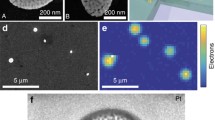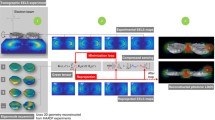Abstract
We reconstruct the optical response of nanostructures of increasing complexity by fitting interferometric time-resolved photoemission electron microscopy (PEEM) data from an ultrashort (21 fs) laser excitation source with different harmonic oscillator-based models. Due to its high spatial resolution of ~40 nm, PEEM is a true near-field imaging system and enables in normal incidence mode a mapping of plasmon polaritons and an intuitive interpretation of the plasmonic behaviour. Using an actively stabilized Mach–Zehnder interferometer, we record two-pulse correlation signals with 50 as time resolution that contain information about the temporal plasmon polariton evolution. Spectral amplitude and phase of excited plasmon polaritons are extracted from the recorded phase-resolved interferometric two-pulse correlation traces. We show that the optical response of a plasmon polariton generated at a gold nanoparticle can be reconstructed from the interferometric two-pulse correlation signal using a single harmonic oscillator model. In contrast, for a corrugated silver surface, a system with increased plasmonic complexity, in general an unambiguous reconstruction of the local optical response based on coupled and uncoupled harmonic oscillators, fails. Whereas for certain local responses different models can be discriminated, this is impossible for other positions. Multidimensional spectroscopy offers a possibility to overcome this limitation.






Similar content being viewed by others
References
U. Kreibig, M. Vollmer, Optical Properties of Metal Clusters (Springer Series in Materials Science), vol. 25 (Springer, Berlin, 1995)
S.A. Maier, Plasmonics: Fundamentals and Applications (Springer, Berlin, 2007)
L. Novotny, B. Hecht, Principles of Nano-Optics (Cambridge University Press, Cambridge, 2006)
A. Anderson, K.S. Deryckx, X.G. Xu, G. Steinmeyer, M.B. Raschke, NanoLett 10, 2519 (2010)
D. Bayer, C. Wiemann, O. Gaier, M. Bauer, M. Aeschlimann, J. Nanomater. 2008, 249514 (2008)
T. Utikal, M.I. Stockman, A.P. Heberle, M. Lippitz, H. Giessen, Phys. Rev. Lett. 104, 113903 (2010)
N.K. Gradya, N.J. Halasa, P. Nordlander, Chem. Phys. Lett. 399(1–3), 167–171 (2004)
M. Merschdorf, C. Kennerknecht, W. Pfeiffer, Phys. Rev. B 70, 193401 (2004)
R. Trebino, Frequency Resolved Optical Gating: The Measurement of Ultrashort Laser Pulses (Kluwer, Boston, 2002)
C. Iaconis, I.A. Walmsley, Opt. Lett. 23(10), 792–794 (1998)
C.A. Schmuttenmaer, M. Aeschlimann, H.E. Elsayed-Ali, R.J.D. Miller, D.A. Mantell, J. Cao, Y. Gao, Phys. Rev. B 50, 8957 (1994)
T. Hertel, E. Knoesel, M. Wolf, G. Ertl, Phys. Rev. Lett. 76, 535 (1996)
H. Petek, S. Ogawa, Prog. Surf. Sci. 56, 239 (1997)
P.M. Echenique, R. Berndt, E.V. Chulkov, Th Fauster, A. Goldmann, U. Höfer, Surf. Sci. Rep. 52, 219–317 (2004)
A. Kubo, K. Onda, H. Petek, Z. Sun, Y.S. Jung, H.K. Kim, Nano Lett. 5, 1123 (2005)
M. Bauer, A. Marienfeld, M. Aeschlimann, Prog. Surf. Sci. 90, 319 (2015)
J. Lehmann, M. Merschdorf, W. Pfeiffer, A. Thon, S. Voll, G. Gerber, Phys. Rev. Lett. 85, 2921 (2000)
Y. Nishiyama, K. Imaeda, K. Imura, H. Okamoto, J. Phys. Chem. C (2015). doi:10.1021/acs.jpcc.5b03341
O. Schmidt, M. Bauer, C. Wiemann, R. Porath, M. Scharte, O. Andreyev, G. Schönhense, M. Aeschlimann, Appl. Phys. B. 74, 223–227 (2002)
Q. Sun, K. Ueno, H. Yu, A. Kubo, Y. Matsuo, H. Misawa, Light Sci. Appl. 2, e118 (2013)
M. Aeschlimann, T. Brixner, S. Cunovic, A. Fischer, P. Melchior, W. Pfeiffer, M. Rohmer, C. Schneider, C. Strüber, P. Tuchscherer, D. Voronine, IEEE J. Sel. Top. Quantum Electron. 18, 275 (2012)
Y. Nishiyama, K. Imaeda, K. Imura, H. Okamoto, J. Phys. Chem. C 119, 16215 (2015)
J.-S. Bouillard, S. Vilain, W. Dickson, A.V. Zayats, Opt. Express 18, 16513 (2010)
L. Novotny, S.J. Stranick, Annu. Rev. Phys. Chem. 57, 303 (2006)
M.B. Raschke, C. Lienau, Appl. Phys. Lett. 83, 5089 (2003)
C. Ropers, C.C. Neacsu, T. Elsaesser, M. Albrecht, M.B. Raschke, C. Lienau, Nano Lett. 7, 2784 (2007)
M. Kociak, O. Stéphan, Chem. Soc. Rev. 43, 3865 (2014)
A. Losquin, M. Kociak, ACS Photonics 2, 1619 (2015)
F.-P. Schmidt, H. Ditlbacher, U. Hohenester, A. Hohenau, F. Hofer, J.R. Krenn, Nano Lett. 12, 5780 (2012)
A. Losquin, S. Camelio, D. Rossouw, M. Besbes, F. Pailloux, D. Babonneau, G.A. Botton, J.-J. Greffet, O. Stéphan, M. Kociak, Phys. Rev. B 88, 115427 (2013)
A. Feist, K.E. Echternkamp, J. Schauss, S.V. Yalunin, S. Schäfer, C. Ropers, Nature 521, 200 (2015)
P. Kahl, S. Wall, C. Witt, C. Schneider, D. Bayer, A. Fischer, P. Melchior, M. Horn-von Hoegen, M. Aeschlimann, F.M. zu Heringdorf, Plasmonics 9(6), 1401–1407 (2014)
N. Fischer, S. Schuppler, Th Fauster, W. Steinmann, Surf. Sci. 314, 89 (1994)
S. Pancharatnam, Proc. Indian Acad. Sci. Sect. A 44, 247 (1956)
M.U. Wehner, M.H. Ulm, M. Wegener, Opt. Lett. 22, 1455 (1997)
J.H. Bechtel, W.L. Smith, N. Bloembergen, Phys. Rev. B 15, 4557 (1977)
J.P. Girardeau-Montaut, C. Girardeau-Montaut, Phys. Rev. B 51, 13560 (1995)
A. Gloskovskii, D. Valdaitsev, S.A. Nepijko, G. Schönhense, B. Rethfeld, Surf. Sci. 601, 4706 (2007)
M.J. Weida, S. Ogawa, H. Nagano, H. Petek, Appl. Phys. A Mater. Sci. Process. 71, 553 (2000)
M. Merschdorf, Femtodynamics in Nanoparticles—The Short Lives of Excited Electrons in Silver (Dissertation, University of Würzburg, 2002)
S. Zhang, D.A. Genov, Y. Wang, M. Liu, X. Zhang, Phys. Rev. Lett. 101, 047401 (2008)
C. Langhammer, B. Kasemo, I. Zorić, J. Chem. Phys. 126, 194702 (2007)
M. Aeschlimann, T. Brixner, A. Fischer, C. Kramer, P. Melchior, W. Pfeiffer, C. Schneider, C. Strüber, P. Tuchscherer, D.V. Voronine, Science 333, 1723–1726 (2011)
P. Tian, D. Keusters, Y. Suzaki, W.S. Warren, Science 300, 1553–1555 (2003)
Acknowledgments
All authors of this work are listed in alphabetical order. This work was supported by the German Science Foundation (DFG) within the SPP 1391 (M.A., T.B., W.P.) and the GSC 266 (P.T.). D.K. acknowledges funding from the Irish Research Council and the Marie Curie Actions ELEVATE fellowship.
Author information
Authors and Affiliations
Corresponding authors
Additional information
This article is part of the topical collection “Ultrafast Nanooptics” guest edited by Martin Aeschlimann and Walter Pfeiffer.
Appendix: Details about the general discriminability between model 2.1 and 2.2
Appendix: Details about the general discriminability between model 2.1 and 2.2
In the following, we summarize our results of a more detailed study of the coupled and uncoupled oscillator models. We show that our models 2.1 and 2.2 lead to different total response functions, while these differences should, in principle, be accessible in a nonlinear measurement, under the assumption of physical reasonable model parameters. In matrix notation, and after a Fourier transformation, the system of linear equations (see Eqs. 12, 13) of our model 2.2 (coupled harmonic oscillators) can be written in the local field basis
as
where
and
Now, the modes of a system of two coupled oscillators can be transformed into a system of two uncoupled ones. That is, there is a matrix U with
where the normal modes Q are the solutions of the equation
The matrix \(N = U^{ - 1} L U\) is a diagonal matrix, such that Q describes the modes of an uncoupled oscillator system. The response functions \(q_{1}\) and q 2, corresponding to the normal modes Q, are simply found by matrix inversion
while the form of the functions \(q_{1}\) and q 2 is given by Lorentzian oscillators. Given Eq. (21), the solutions Q are
If we then plug Eq. (23) into Eq. (20), we get
and together with the definition of the response function in the local basis
Equation (24) can be transformed into
If we now write out the matrix multiplications, we can factor out the response functions \(q_{1}\) and q 2, by using Eq. (22)
So, we find the decomposition of the response functions R 1/2 (local basis) into the response functions q 1/2 (normal basis)
where we defined the coefficients
The total response functions which enter our model calculations are taken as linear combinations of the individual response functions \(R_{1}\) and R 2 in the local basis (see Eq. 11) with two real coefficients a 1, \(a_{2}\). If we expand the total response function R (in the local basis), with the help of Eq. (28), we get
The expansion coefficients are found to be
Now there are two important points to note:
-
1.
The expansion coefficients can be complex-valued numbers.
-
2.
As soon as γ 1 ≠ γ 2, these coefficients become complex-valued functions of \(\omega\), which leads to a unique frequency-dependent relative phase between the modes \(q_{1}\) and q 2.
While these frequency-dependent coefficients have inevitably an effect on the temporal structure of the resulting autocorrelation traces, we can conclude that, comparing model 2.1 and model 2.2, differences should be detectable, and therefore, a discriminability of both models is given.
Rights and permissions
About this article
Cite this article
Aeschlimann, M., Brixner, T., Fischer, A. et al. Determination of local optical response functions of nanostructures with increasing complexity by using single and coupled Lorentzian oscillator models. Appl. Phys. B 122, 199 (2016). https://doi.org/10.1007/s00340-016-6471-3
Received:
Accepted:
Published:
DOI: https://doi.org/10.1007/s00340-016-6471-3




